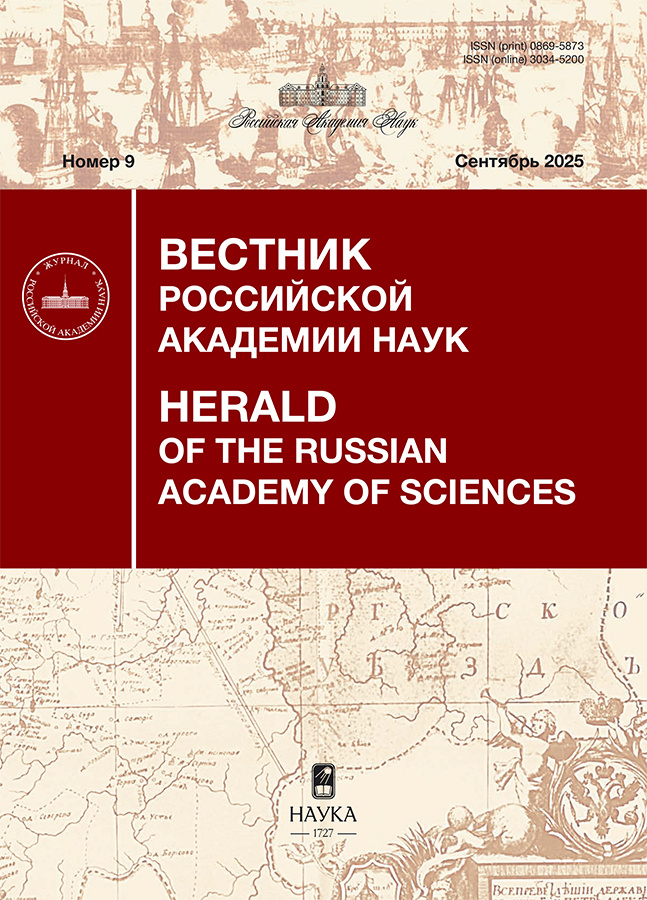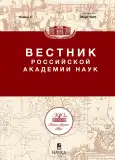Вызовы машинного обучения и математическое моделирование
- Авторы: Ильин В.П.1,2
-
Учреждения:
- Институт вычислительной математики и математической геофизики СО РАН
- Новосибирский государственный технический университет
- Выпуск: № 3 (2025)
- Страницы: 15–24
- Раздел: ТОЧКА ЗРЕНИЯ
- URL: https://journal-vniispk.ru/0869-5873/article/view/292356
- DOI: https://doi.org/10.31857/S0869587325030021
- EDN: https://elibrary.ru/CTOIHN
- ID: 292356
Цитировать
Аннотация
В статье рассмотрены вызовы и проблемы машинного обучения, возникающие в суперкомпьютерном математическом моделировании процессов и явлений реального мира. В настоящее время такое моделирование стало основным инструментом получения фундаментальных и прикладных знаний, а также условием заметного повышения производительности труда и внутреннего валового продукта. Описаны принципы современного предсказательного моделирования на основе высокопроизводительных вычислений, искусственного интеллекта и обработки больших объёмов данных. Проанализированы тенденции развития наукоёмкого математического и программного обеспечения в рамках интегрированных вычислительных окружений; последние предполагают гибкое расширение состава изучаемых моделей и применяемых алгоритмов, эффективное использование внешних продуктов, адаптацию к эволюции компьютерных платформ, ориентированных на длительный жизненный цикл. Изложена методология машинного обучения на основе технологического цикла, который включает формирование и модификацию моделей, реализацию вычислительного эксперимента с решением прямых и обратных задач, анализ результатов и принятие решений по оптимизации видов деятельности для достижения поставленных целей.
Об авторах
В. П. Ильин
Институт вычислительной математики и математической геофизики СО РАН; Новосибирский государственный технический университет
Автор, ответственный за переписку.
Email: ilin@sscc.ru
доктор физико-математических наук, главный научный сотрудник лаборатории вычислительной физики
Россия, Новосибирск; НовосибирскСписок литературы
- LeCun Y., Bengio Y., Hinton G. Deep learning // Nature. 2015, vol. 521, pp. 436–444.
- Weinan E. Machine learning and computational mathematics // Commun. Comput. Phys. 2020, vol. 28, pp. 1639–1670.
- Dongarra J., Grigori L., Higham N.J. Numerical algorithms for high performance computational science // Phil. Trans. R. Soc. 2020, vol. 378, iss. 2166.
- Xu Y., Zeng Т. Sparse Deep Neural Network for Nonlinear Partial Differential // Equations. Numer. Math. Theor. Meth. Appl. 2022, vol. 16, no. 1, pp. 58–78.
- Ильин В.П. Математическое моделирование: философия науки // Сб. научно-поп. статей “Математика, механика и информатика”. М., 2017. С. 8–16. Il’in V.P. Mathematical modeling: The philosophy of science // Collection of Popular Science Articles “Mathematics, Mechanics, and Informatics”. Moscow, 2017. Pp. 8–16. (In Russ.) Il’in V.P. Artificial intelligence problems in mathematical modeling // Voevodin V., Sobolev S. (eds.) Russian supercomputing days 2019. CCIS – Springer. 2019, vol. 1129, pp. 505–516.
- Forrester A., Sobester A., Keane A. Engineering Design via Surrogate Modeling: A Practical Guide. Wiley, New York, 2008.
- Яненко Н.Н., Коновалов А.Н. Некоторые вопросы теории модульного анализа и параллельного программирования для задач математической физики и механики сплошной среды // Современные проблемы математической физики и вычислительной математики. М.: Наука, 1982. С. 200–217. Yanenko N.N., Konovalov A.N. Some questions of the theory of modular analysis and parallel programming for problems of mathematical physics and continuum mechanics // Modern Problems of Mathematical Physics and Computational Mathematics. Moscow: Nauka, 1982. Pp. 200–217. (In Russ.)
- Яненко Н.Н., Рычков А.Д. Актуальные проблемы прикладной математики и математического моделирования. Новосибирск: Наука, 1982. Yanenko N.N., Rychkov A.D. Topical Problems of Applied Mathematics and Mathematical Modeling. Novosibirsk: Nauka, 1982. (In Russ.)
- Ершов А.П., Ильин В.П. Пакеты программ – технология решения прикладных задач. Новосибирск: ВЦ СО АН СССР. Препринт № 121, 1978. Ershov A.P., Il’in V.P. Software packages: Technology for solving applied problems. Preprint no. 121. Computer Center of the Siberian Branch of the USSR Acad. Sci. Novosibirsk, 1978.
- Самарский А.А., Михайлов А.П. Математическое моделирование. М.: Физматлит, 2002. Samarskii A.A., Mikhailov A.P. Mathematical Modeling/ (Moscow: Fizmatgiz, 2002. (In Russ.)
- Ильин В.П. Как реорганизовать вычислительные науки и технологии // Вестник РАН. 2019. № 2. С. 232–242. Il’in V.P. How to reorganize computer science and technology // Vestn. Ross. Akad. Nauk. 2019, no. 2, pp. 232–242. (In Russ.)
- Ильин В.П. Математическое моделирование. Ч. 1. Непрерывные и дискретные модели. Новосибирск: Изд-во СО РАН, 2017. Il’in V.P. Mathematical Modeling. Part 1. Continuous and Discrete Models. Novosibirsk: SB RAS, 2017. (In Russ.)
- Il’in V.P. Iterative Preconditioned Methods in Krylov Spaces: Trends of the XXI Century // Computational Mathematics and Mathematical Physics. 2021, vol. 61, no. 11, pp. 1750–1775.
- Il’in V.P. Integrated Computational Environment for Grid Generation Parallel Technologies / L. Sokolinsky, M. Zymbler (eds.). CCIS. 2020, vol. 1263, pp. 58–68.
- Бутюгин Д.С., Ильин В.П. CHEBYSHEV: принципы автоматизации построения алгоритмов в интегрированной среде для сеточных аппроксимаций начально-краевых задач // Труды Международной конференции ПАВТ 2014. Челябинск: изд-во ЮУрГУ, 2014. С. 42–50. Butyugin D.S., Il’in V.P. CHEBYSHEV: Principles of automating the construction of algorithms in an integrated environment for grid approximations of initial-boundary value problems // Proceedings of the International Conference PAVT’2014. Chelyabinsk, 2014). Pp. 42–50. (In Russ.)
- Валиуллин А.Н., Ганжа В.Г., Ильин В.П., Яненко Н.Н. Задача автоматического построения и исследования на ЭВМ разностных схем в аналитическом виде // Доклады АН СССР. 1984. T. 275. № 3. С. 528–532. Valiullin A.N., Ganzha V.G., II’in V.P., Shapeev V.P., Yanenko N.N. Problem of automatic generation and investigation of difference schemes in symbolic form on a computer // DAN SSSR. 1984, vol. 275, no. 3, p. 528–532. (In Russ.)
- Il’in V.P. Parallel intelligent computing in algebraic problems / Sokolinsky. Parallel Computational Technologies. Communications in Computer and Information Science. 2021, vol. 1437, рр. 108–117.
- Il’in V. P.The integrated computational environment for optimization of complex systems // Proceedings of the 15th International Asian School-Seminar “Optimization Problems of Complex Systems” 2019. Pp. 65–67. https://doi.org/10.1109/opcs.2019.888015
- Il’in V.P., Skopin I.N. About performance and intellectuality of supercomputer modeling // Programming and Computer Software. 2016, vol. 42, iss. 1, pp. 5–16.
- Ушаков Д.М. Введение в математические основы САПР. Новосибирск: ЗАО “ЛЕДАС”, 2008.
- Ushakov D.M. Introduction to mathematical foundations of CAD. Novosibirsk, LEDAS Publ., 2008. (In Russ.)
- Bastian P., Blatt M., Dedner A. et al. The Dune Framework: Basic Concepts and Recent Developments, Computers and Mathematics with Applications, 2020. DOI.org/10.1016/j.camwa.2020.06.007
- OpenFOAM. https://www.openfoam.com/
- INMOST: A Toolkit for Distributed Mathematical Modeling. https://www.inmost.org
- Kleppe A. Software language engineering: Creating domain-specific language using metamodels. N.Y.: Addison-Wesley, 2008.
- DVM Systems. http://www.keldush.ru/dvm
- Aleeva V. Designing Parallel Programs on the Base of the Conception of Determinant // Supercomputing. RuSCDays 2018 (Communications in Computer and Information Science). 2019, vol. 965, pp. 565–577.
- Allan B., Armstrong R., Wolfe A. et al. The CCA Core specification in a Distributed Memory // SPMD Framework Concurrent Practice and Expedience. 2002, vol. 14, pp. 323–345.
- Malyshkin V.E. Active knowledge, LuNA and literacy for oncoming centuries // LNCS. 2015, vol. 9465, pp. 292–303.
- Ильин В.П. Концепция и архитектура базы знаний систем линейных алгебраических уравнений // Материалы IX конференции “Знания–Онтологии–Теории” 2023, 2–6 октября 2023 г. Новосибирск: ИСИ СОРАН, 2023. С. 143–154. Il’in V.P. The conception and architecture of the knowledge base of the systems of linear algebraic equations // Procced. IX Conference “Knowledge-Ontology-Theory”. Novosibirsk: ISI SBRAS, 2023. Pp. 143–154. (In Russ.)
- Antonov A., Dongarra J., Voevodin V. AlgoWiki Project as an Extension of the Top500 Methodology // Supercomput. Frontiers and Innovations. 2018, vol. 5, no. 1, pp. 4–10.
- Yang S., Nachum O., Du Yi. et all. Foundation Models for Decision Making: Problems, Methods, and Opportunities. ArXiv, abs/2303.04129. [cs. AI] 7 mar 2023.
- Grossmann T.G, Komorowska U.J., Latz J., Schönlieb C. Can physics informed neural networks beat the finite element method? // IMA Journal of Applied Mathematics, 2024, p. hxae011.
- Rudikov A., Fanaskov V., Muravleva E. et al. Neural operators meet conjugate gradients: The FCG-NO method for efficient PDE solving // Proceedings of the 41st International Conference on Machine Learning, ICML 2024, 2024.
- Goswami S., Bora A., Yu Y., Karniadakis G.E. Physics-informed deep neural operator networks // Machine Learning in Modeling and Simulation: Methods and Applications, Springer, 2023, pp. 219–254.
- Vaswani A. et al. Attention Is All Yоu Need // Proceed. of 31st Conference on Neural Information Processing Systems. NIPS. 2017, pp. 1–11.
- Srinivasan Р., Demuriya О., Grabowski В., Shapeev A.V. Electronic moment tensor potentials include both electronic and vibrational degrees of freedom // Computational Materials. 2024, vol. 10, iss. 1, id. 41.
- Fanaskov V.S., Oseledets I.V. Spectral neural operators // Doklady Mathematics. 2023, vol. 108, pp. S226–S232.
- Альтшуллер Г.С. Найти идею. Введение в теорию решения изобретательских задач. Новосибирск: Наука, 1986. Altshuller G.S. To find idea. The introduction into theory of solving the invent tasks. Novosibirsk: Nauka, 1986. (In Russ.)
- Zagorulko Yu., Zagorulko G. Architecture of extensible tools for development of intelligent decision support systems // New Trends in Software Methodologies, Tools and Techniques. Proc. of the 10th SoMeT-11. Hamido Fujita (Eds.). Amsterdam: IOS Press, 2011. Pp. 457–466.
- Bommasani R., Hudsa D.A., Adeli E. et al. On the opportunities and Risks of Foundation Models. CRFM, Stanford, 2021. doi: 10.48550/arXiv.2108.07258.
- Ильин В.П. Программирование ближайшего будущего: концепция и прагматика // Вестник РАН. 2023. № 2. С. 150–161. doi: 10.31857/S086958732302007X Ilyin V.P. Programming for the Near Future: Concepts and Pragmatic Considerations // Her. Russ. Acad. Sci. 2023, no. 1, pp. 92–102. https://doi.org/10.1134/S1019331623010112 (In Russ.)
- Luccioni A., Bengio Yо. On the Morality of Artificial Intelligence. arXiv:1912.11945 [cs.CY] https://doi.org/10.48550/arXiv.1912.11945
Дополнительные файлы










